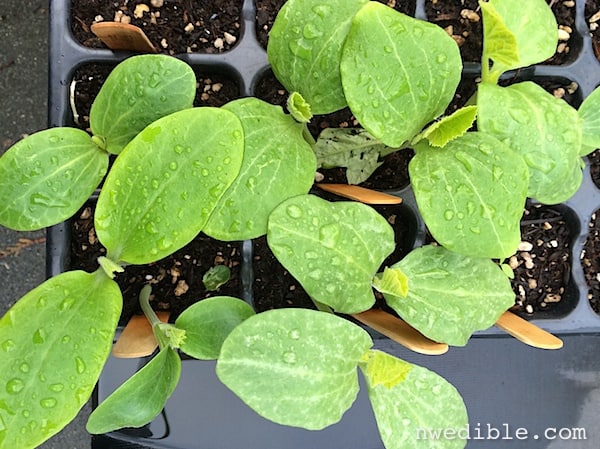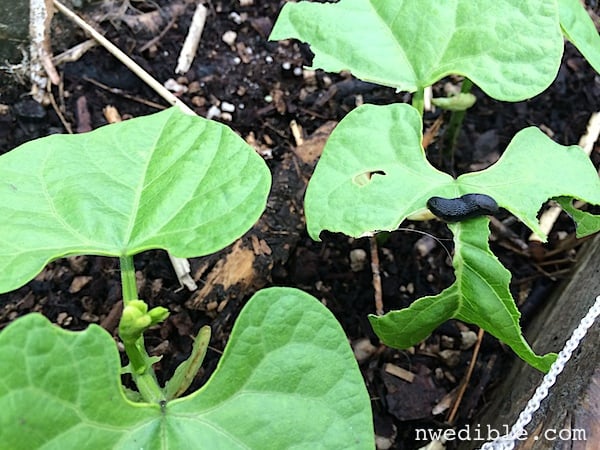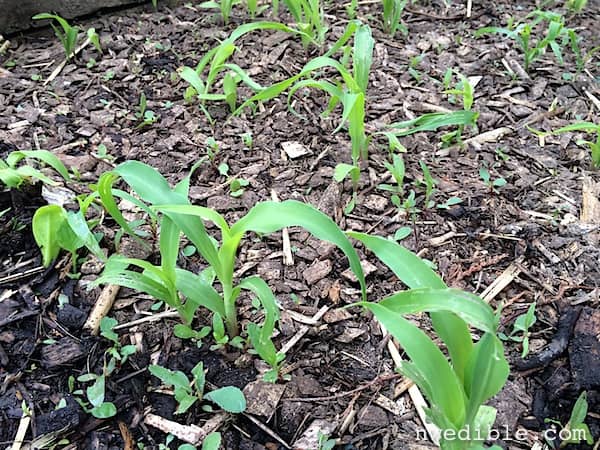May is a month of promise – amnesia about last year’s failures has taken hold and it’s easy to convince ourselves that this will be the year everything goes right. Weeds will never germinate, pests and diseases will not visit us, perfectly ripe produce will leaps forth like Athena from the forehead of Zeus and the children will cheerfully ask to harvest green beans by the bucketful. Gardening is hope, doggedly staying one step ahead of experience. And so, joyfully and knowingly deluded, we step into May.

Plan & Purchase
Warm season edibles – tomatoes, peppers, beans, eggplant, melon, cucumber and corn – are in the nurseries, garden centers, big box store, farmer’s markets and more now. It’s tempting to buy the larger size transplants, but a 4″ tomato and a gallon tomato may be only a week growing difference and typically smaller plants establish and transplant better than older ones. So feel ok saving some money. (Learn more: How To Spot and Avoid a Crappy Seedling.)

Start thinking about the fall garden. No, you don’t have to do anything yet, but just keep it in the back of your head that many of the fall and winter crops like Brussels Sprouts and some of the long-season cabbages mature veeeeerrrrry slowly, and will need to be started in late June or early July to give you a satisfactory harvest. So start thinking about your fall crops now and make sure you have what seed you’ll need and that some space in the garden beds will be available when the time comes. (Learn More: How To Make Succession Planting and Year-Round Gardening Really Work.)
Sow Indoors

At this point everything can be sown out directly, which is less work and energy than starting crops indoors. But you may still prefer to get some crops going under lights, or in small pots in the greenhouse or cold frame, to have at the ready.

I hate you slugs! I hate you!
The biggest reason I give some of these warm-season crops a head start under lights is because I’ve had too many rows of just-germinated cucumbers devoured in a single night by slugs. I’ve lost entire rows of beans this year to the slugs and I’m not happy about it. (Sluggo – must buy more Sluggo.) That said, nothing in the curbit (squash) family really loves being transplanted, so don’t let those crops languish in pots too long before transplanting.
- Summer and winter squash
- Melons
- Beans
- Corn
- Basil and other tender herbs
- Continue to start salad greens indoors to have little lettuces, etc. ready to pop into any open patch of ground.
- Continue to start brassicas like broccoli, cauliflower, cabbages, etc. indoors for late summer/early fall harvests.
Sow & Plant Outside
We’re really into direct-sow time of year now! Keep top layers of soil moist for germinating seeds and be prepared to cover seedlings with a low tunnel cloche or individual cloches in the evenings until overnight temps are reliably above 55-degrees.

It’s definitely safe to direct seed beans, squash, cucumber and corn now. My preferred method to direct sow heat lovers like corn and squash is to plant these crops under clear plastic and rely on the increased soil temp to give me strong and early germination. Just be careful temps under the plastic don’t get so hot that you cook your seeds or newly germinated seedlings.

With a bit of help from clear plastic, my direct-sown corn is several inches high on the fifth of May.
If you are behind on your plantings of spring crops, don’t feel too bad – delay generally means super fast germination, so it’s not too late for lettuces and radishes and other favorites. It’s even still worth sticking enation-resistant peas and short season potatoes in the ground.
- Squashes – winter and summer squash can be seeded now with appropriate protection for chillier nights and microclimates.
- Beans – Bush and pole beans. Scarlet runner is the most cool-night-tolerant bean I grow.
- Brassicas – broccoli, cauliflower, cabbage, brussels sprouts, kohlrabi and kale can be sown directly in the ground now. Make sure you are planting varieties that will mature quickly (if you want to eat them in mid/late summer) or slowly (if you want them to be fall crops).
- Root Vegetables – beets, carrots, radishes parsnips, root parsley and turnips. These can all be planted. You will have the best results in loose open soil and I encourage you to cover your carrot and parsnip seedlings with row cover to prevent the dreaded carrot root maggot from destroying your veggies.
- Corn – It’s wind pollinated, so for successful ears you need to sow it in blocks, not rows. My old-timer veggie gardener neighbor tells me that a 4 x 4 block (16 total corn plants) is the minimum for reliable pollination. I’d go for at least twice that.
- Greens – lettuce, New Zealand spinach, mustards, arugula, mache, Asian greens, cress and greens mixes can be sown directly for salad and quick sautes. Mustards and arugula especially tend to bolt at the drop of a hat this time of year, so harvest those greens young!
- Swiss Chard – I love it!
- Onions – green onions and leeks can be sown. Onion sets and starts can still be put those in for small onions (get on it!), but it’s too late to start a bulb onion patch from seed for this year.
- Potatoes – Still fine to plant through May, depending on when you want to harvest them and what variety you grow. I’ve planted short-season Yukon Golds as late as June and they’ve done great.
- Herbs: Chives, parsley, mints, marjoram, oregano, dill, fennel, borage, cilantro, fennel, basil and the like can all be sown out.
Use Overnight Lows To Judge Transplant Times
May is when folks in more extreme-winter climates can typically go out and “put in the garden.” My gardening friends in the upper midwest tell me that May goes like this: basically winter, then Memorial Day, then basically summer.
Spring is a fast transition from cold to hot in many places. The Maritime Northwest is not one of those places. Here, spring can be tenacious. May will see glorious clear days in the 70s, or a week of grey skies and rain. Probably both. It’s a slow path to summer, with overnight lows only granny gearing their way into the 50s. (Some years they don’t make it until August.)

Those overnight lows are important: keep a careful eye on them, because they’re the best metric to determine when you can start transplanting the heat loving tomatoes, peppers, and whatever else you might have started. I like to see overnight lows consistently above 50 before I move my ‘maters out. I pushed it a bit this year and I think my tomatoes are resenting me a bit for it. Peppers would be better at 60, but that ain’t happening around here, so I rely on season extension, microclimate hacking, and good old fashioned finger crossing.
This year, it seems to me that early May is a safe bet for moving a hardened tomatoes outdoors. Give the tender shop-bought starts a nice week of transition before you move them into their forever home.
This month you can set out seedlings of the following. All will benefit from season extension techniques and the more tender require them at this time of year.
- Tomatoes
- Peppers (cloche!)
- Summer and Winter Squash
- Cucumber
- Corn
- Eggplant – maybe at the end of the month. Pull out all the heat-holding stops for this one.
- Melons – like eggplant, give those melons all the heat you can and don’t rush them out.
Harvest
After the first few weeks of the Eat From The Larder Challenge in April, I despaired of ever eating a fresh vegetable again. And then, finally, my lettuce was mature enough for a salad! How wonderful! Nothing makes you appreciate the taste of lettuce more than not having it. And now, only a few weeks later, it’s like everything is just bursting into growth and I can barely keep up with those patches of lettuce that I was so eager to chivy along in April.

- Salad Greens – new crop lettuce and spinach are tender and delicious. Lots to choose from these days.
- Rhubarb – very harvestable.
- Asparagus – Should be coming up by now. Are you harvesting already?
- Spring cauliflowers – I have one more Maystar I’m waiting on.
- Chard – Chard is growing well. No overwintered chard for me this year, but the new seedlings are settling in nicely.
- Kale – My new kales are growing very strong.
- Overwintering carrots and beets – possibly the tastiest kind!
- Radishes – my Valentine’s Day mix is maturing about a nice bunch of radishes a day right now.
- Herbs – chives, tarragon, lemon balm, mint, parsley and cilantro are all growing. All the woody herbs are putting on lots of new growth. Chocolate mint is everywhere in my yard but I’m not complaining: chocolate mint mojito, anyone?

Yay May! How’s your garden doing this spring?
1
I enjoyed reading this “to do” list. Hopefully spring is finally here, sigh. Just a suggestion, regarding the issue with carrot maggots, the row covers are an excellent idea, but also throw in some radish seeds as well. Radishes are a great “trap” crop for many insect pests. Since the germinate so quickly the pest normally go for those first. Ragged out radishes can be pulled up and tossed, leaving you with a lot fewer pests to deal with. Companion planting is a great way to help minimize insect damage and the plants love it.
Great to-do list…I’ll pass it over to my husband. Just kidding.
I like planting a couple of my favorite herbs in pots so I can bring them inside when the frost comes. Hey, it gives me an extra month on my basil, thyme, sage and a few others.
Fresh herbs always make me pass myself as a better cook than I really am!
Thank you for the blog, this is the first and only one I have ever actually followed. I love these to do lists. I am just a little south east of you on Hood Canal and so pretty much on the same calendar. Thanks for helping me stay on track!
I have a question about feeding. What are your fertilization/soil management practices? I am learning the lesson about the nitrogen cycle the hard way this year… Nothing has been growing! What do you particularly for nitrogen? Is one application of compost a year enough to keep your garden growing?
I heard that white clover planted around brassicas can fix nitrogen for you. I’ve never tried it myself.
Erica,
Great post, as usual! These monthly updates are so helpful. I just planted my tomatoes this weekend (in between bouts of pouring rain!), and they are happily residing under cloches. Seeing pictures of yours made me wonder about something, though: can you do a post with more details about what you do for tomato support? It seems like every year I am reinventing the wheel on this one, and I would like to stop! Specifically, how do you handle the cloche-to-support transition? That’s the thing that trips me up — it seems like so many supports are incompatible with cloches, and it’s a big hassle to figure out how to do the switch after the weather has warmed up, but before the tomatoes are sprawling all over the ground. Advice please?
Something ate my scallion seedlings. They were here one day, and gone the next. Guess I’ll plant again and keep my fingers crossed. Everything else is coming along well. My snap pea vines are pretty tall, and I’m about to pull the vines that I planted specifically for the shoots to make room for my tomatoes. Potato leaves are coming up from the soil, too.
Thanks for the planting date suggestion for eggplant. This is my third attempt, my starts always die off. By the end of the month I’m gonna plant one in a raised bed and another in a container. Fingers crossed that I get some fruit this time.
North-East here, upstate NY infact. We’re getting a frost tonight, though it shouldn’t be TO bad of one. Peppers are actually out, planted in black tires to help keep them warm, but the’re already under row covers for the night. I’m hoping that the rest of the plants can be planted in the next week, but I’ll be keeping the frost covers handy through the end of the month!
Oh woe is me……just when we’re patting ourselves on the back……peas are gaining, lettuce thriving, Chinese greens greening……cutworms! Little dead green soldiers everywhere….sigh. Going out today to buy nematodes. Cutworm Armageddon is about to commence in Graham.
Otherwise, loving the weather and garden today.
I have similar questions as Tania above. What is your process for maintaining soil fertility and having healthy, stable soil throughout the year.
I’ve read that Sluggo may kill earthworms, and I’ve been afraid to use it. Do you have an opinion on the subject? I live in San Diego, with terrible water and soil and a very sad little garden, so really, the slugs are the least of my worries, but we’ve had slug trouble in other places too. I’m just playing at gardening til we move to a better growing location, and trying to learn some basics before we start in earnest…